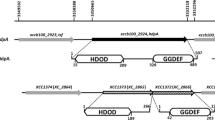Abstract
Xanthomonas axonopodis pv. citri (X. axonopodis pv. citri) possesses two lexA genes, designated lexA1 and lexA2. Electrophoretic mobility shift data show that LexA1 binds to both lexA1 and lexA2 promoters, but LexA2 does not bind to the lexA1 promoter, suggesting that LexA1 and LexA2 play different roles in regulating the expression of SOS genes. In this study, we have determined that LexA2 binds to a 14-bp dyad–spacer–dyad palindromic sequence, 5′-TGTACAAATGTACA-3′, located at nucleotides −41 to −28 relative to the translation start site of lexA2 of X. axonopodis pv. citri. The two spacer nucleotides in this sequence can be changed from AA to TT without affecting LexA2 binding; all other base deletions or substitutions abolish LexA2 binding. The LexA1 binding sequence in the promoter region of lexA2 is TTAGTACTAAAGTTATAA and is located at −133 to −116, and that in the lexA1 gene is AGTAGTAATACTACT located at nucleotides −19 to −5 relative to the translation start site of lexA1. Any base change in the latter sequence abolishes LexA1 binding.






Similar content being viewed by others
References
Brent R, Ptashne M (1981) Mechanism of action of the lexA gene product. Proc Natl Acad Sci USA 78:4204–4208
Brooks PC, Movahedzadeh F, Davis EO (2001) Identification of some DNA damage-inducible genes of Mycobacterium tuberculosis: apparent lack of correlation with LexA binding. J Bacteriol 183:4459–4467
Calero S, Garriga X, Barbe J (1991) One-step cloning system for isolation of bacterial lexA-like genes. J Bacteriol 173:7345–7350
Campoy S, Mazon G, Fernandez de Henestrosa AR, Llagostera M, Monteiro PB, Barbe J (2002) A new regulatory DNA motif of the gamma subclass Proteobacteria: identification of the LexA protein binding site of the plant pathogen Xylella fastidiosa. Microbiology 148:3583–3597
del Rey A, Diestra J, Fernandez de Henestrosa AR, Barbe J (1999) Determination of the Paracoccus denitrificans SOS box. Microbiology 145(Pt 3):577–584
Erill I, Escribano M, Campoy S, Barbe J (2003) In silico analysis reveals substantial variability in the gene contents of the gamma proteobacteria LexA-regulon. Bioinformatics 19:2225–2236
Fernandez de Henestrosa AR, Rivera E, Tapias A, Barbe J (1998) Identification of the Rhodobacter sphaeroides SOS box. Mol Microbiol 28:991–1003
Fernandez De Henestrosa AR, Ogi T, Aoyagi S, Chafin D, Hayes JJ, Ohmori H, Woodgate R (2000) Identification of additional genes belonging to the LexA regulon in Escherichia coli. Mol Microbiol 35:1560–1572
Fernandez de Henestrosa AR, Cune J, Mazon G, Dubbels BL, Bazylinski DA, Barbe J (2003) Characterization of a new LexA binding motif in the marine magnetotactic bacterium strain MC-1. J Bacteriol 185:447144–447182
Garriga X, Calero S, Barbe J (1992) Nucleotide sequence analysis and comparison of the lexA genes from Salmonella typhimurium, Erwinia carotovora, Pseudomonas aeruginosa and Pseudomonas putida. Mol Gen Genet 236:125–134
Humayun MZ (1998) SOS and mayday: multiple inducible mutagenic pathways in Escherichia coli. Mol Microbiol 30:905–910
Jara M, Nunez C, Campoy S, Fernandez de Henestrosa AR, Lovley DR, Barbe J (2003) Geobacter sulfurreducens has two autoregulated lexA genes whose products do not bind the recA promoter: differing responses of lexA and recA to DNA damage. J Bacteriol 185:2493–2502
Little JW (1993) LexA cleavage and other self-processing reactions. J Bacteriol 175:4943–4950
Little JW, Mount DW (1982) The SOS regulatory system of Escherichia coli. Cell 29:11–22
Little JW, Mount DW, Yanisch-Perron CR (1981) Purified lexA protein is a repressor of the recA and lexA genes. Proc Natl Acad Sci USA 78:4199–4203
Mazon G, Lucena JM, Campoy S, Fernandez de Henestrosa AR, Candau P, Barbe J (2004) LexA-binding sequences in Gram-positive and cyanobacteria are closely related. Mol Gen Genomics 271:40–49
Tapias A, Barbe J (1999) Regulation of divergent transcription from the uvrA-ssb promoters in Sinorhizobium meliloti. Mol Gen Genet 262:121–130
Walker GC (1984) Mutagenesis and inducible responses to deoxyribonucleic acid damage in Escherichia coli. Microbiol Rev 48:60–93
Weinel C, Nelson KE, Tummler B (2002) Global features of the Pseudomonas putida KT2440 genome sequence. Environ Microbiol 4:809–818
Weng SF, Shieh MY, Lai FY, Shao YY, Lin JW, Tseng YH (1996) Construction of a broad-host-range promoter-probing vector and cloning of promoter fragments of Xanthomonas campestris. Biochem Biophys Res Commun 228:386–390
Wertman KF, Mount DW (1985) Nucleotide sequence binding specificity of the LexA repressor of Escherichia coli K-12. J Bacteriol 163:376–384
Winterling KW, Levine AS, Yasbin RE, Woodgate R (1997) Characterization of DinR, the Bacillus subtilis SOS repressor. J Bacteriol 179:1698–1703
Winterling KW, Chafin D, Hayes JJ, Sun J, Levine AS, Yasbin RE, Woodgate R (1998) The Bacillus subtilis DinR binding site: redefinition of the consensus sequence. J Bacteriol 180:2201–2211
Yang MK, Wu PI, Yang YC (2000) Identification of a lexA gene in, and construction of a lexA mutant of, Xanthomonas campestris pv. citri. Curr Microbiol 40:233–238
Yang YC, Yang MK, Kuo TT, Tu J (2001) Structural and functional characterization of the lexA gene of Xanthomonas campestris pathovar citri. Mol Genet Genomics 265:316–326
Yang MK, Yang YC, Hsu CH (2002) Characterization of Xanthomonas axonopodis pv. citri LexA: recognition of the LexA binding site. Mol Genet Genomics 268:477–487
Yang MK, Su SR, Sung VL (2005) Identification and characterization of a second lexA gene of Xanthomonas axonopodis pathovar citri. Appl Environ Microbiol 71:3589–3598
Acknowledgments
The authors thank Chao-Hung Lee for valuable discussions and critical editing of the manuscript. This study was supported by a grant (NSC95-2311-B-030-001) from the National Science Council, Taipei, Taiwan.
Author information
Authors and Affiliations
Corresponding author
Additional information
Communicated by G. Klug.
Rights and permissions
About this article
Cite this article
Yang, MK., Hsu, CH. & Sung, VL. Analyses of binding sequences of the two LexA proteins of Xanthomonas axonopodis pathovar citri. Mol Genet Genomics 280, 49–58 (2008). https://doi.org/10.1007/s00438-008-0344-3
Received:
Accepted:
Published:
Issue Date:
DOI: https://doi.org/10.1007/s00438-008-0344-3




